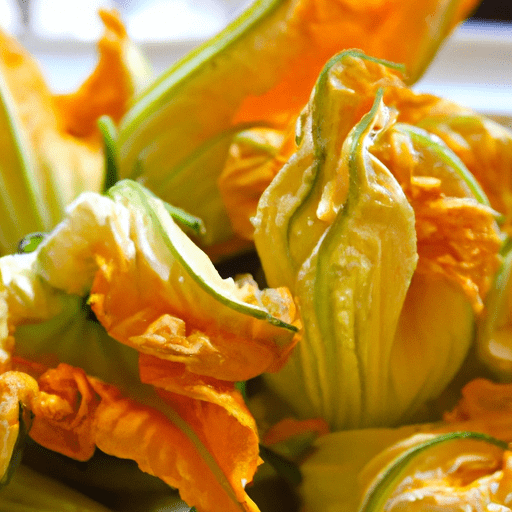Exploring Flor de Calabaza: A Delicious and Versatile Ingredient
Flor de Calabaza, also known as squash blossoms, is a delightful and versatile ingredient that adds a touch of elegance to any dish. These bright yellow flowers not only provide a visually stunning presentation but also offer a unique flavor to elevate your culinary creations. In this blog post, we will delve into the taste, culinary uses, nutritional value, and fascinating history of Flor de Calabaza.
Taste
Squash blossoms possess a subtle and delicate flavor that is often described as a combination of zucchini and floral notes. This delicate taste allows them to complement a wide variety of ingredients without overpowering the dish. Whether cooked or eaten raw, Flor de Calabaza provides a refreshing and vibrant burst of flavor that has captivated food enthusiasts around the world.
Common Uses in Cooking
Flor de Calabaza is a cherished ingredient in numerous culinary traditions, particularly in Mexican and Mediterranean cuisines. These beautiful blooms are incredibly versatile, lending themselves to both savory and sweet preparations. Here are some common ways to incorporate Flor de Calabaza in your cooking:
Stuffed and Fried: One of the most popular and indulgent preparations is to stuff the blossoms with a flavorful filling, such as cheese, herbs, or cooked meats, and then lightly fry them until golden and crispy. The result is a divine appetizer or side dish that bursts with contrasting textures and flavors.
Sautéed: Another delightful option is to sauté squash blossoms with olive oil, garlic, and herbs. This simple yet elegant method allows the delicate flavor of Flor de Calabaza to shine through, making it a perfect addition to pastas, risottos, or simply enjoyed as a side dish.
In Soups and Stews: Squash blossoms can be added to soups and stews during the final stages of cooking to impart a subtle floral essence. They add an element of sophistication to any dish and are particularly popular in traditional Mexican dishes like caldo de flor de calabaza.
Salads and Garnishes: For a lighter touch, add Flor de Calabaza to salads, sandwiches, or use them as a beautiful edible garnish for your dishes. Their vibrant yellow color and delicate petals make any plate look more visually appealing.
Nutritional Value
Apart from being a culinary delight, Flor de Calabaza also offers several health benefits. These blossoms are low in calories and fat while being a rich source of essential vitamins and minerals. They are particularly high in vitamins A and C, which are known for their antioxidant properties and support immune health. Additionally, squash blossoms are a good source of calcium, iron, and magnesium, all crucial minerals for maintaining strong bones and overall well-being.
History and Interesting Facts
Squash blossoms have a long and rich history, with their culinary use dating back centuries. Indigenous cultures in Mexico were among the first to recognize their culinary potential and incorporate them into their traditional dishes. Flor de Calabaza has since become an indispensable ingredient in Mexican cuisine, captivating both locals and international food enthusiasts.
In addition to their culinary value, squash blossoms have also been used for their medicinal properties throughout history. Traditional remedies include using them to alleviate stomach ailments and even improve sleep quality.
Conclusion
Flor de Calabaza, with its delicate flavor, vibrant appearance, and rich history, is a true gem in the culinary world. Whether you choose to stuff and fry them, sauté them, or add them to soups and salads, these squash blossoms are sure to elevate any dish to new heights. So, next time you come across Flor de Calabaza, embrace the opportunity to explore its culinary possibilities and create an unforgettable dining experience.
Flor de Calabaza
Origin: Flor de Calabaza, also known as squash blossoms, is native to Central and South America. It has been a staple in the cuisine of Mexico since ancient times.
Common Uses: These edible flowers are highly valued in Mexican, Italian, and Mediterranean cuisines. They are often used as a filling or garnish in various dishes. In Mexican cuisine, the most popular use is in quesadillas or stuffed with cheese and fried. In Italian cuisine, they are commonly used in risottos, pasta dishes, and frittatas.
Nutritional Benefits: Flor de Calabaza is low in calories and a good source of essential nutrients. It contains vitamin C, vitamin A, potassium, and fiber. It also provides antioxidants that can help protect the body against oxidative stress and inflammation.
Unique Properties: Squash blossoms have a delicate and slightly sweet flavor, similar to zucchini. The flowers have a bright yellow-orange color and a fragile texture. They are generally harvested in the morning when they are still fresh and open.
Historical Significance: Flor de Calabaza has been used in Mexican cuisine for centuries. It has an important cultural and historical significance, representing a connection to indigenous traditions and culinary heritage. These blossoms were also an important food source for native civilizations, providing nutrients during times of scarcity.
Remember, when using squash blossoms for cooking, make sure to remove the stamen and pistil from the center of each flower.




Use the share button below if you liked it.
It makes me smile, when I see it.